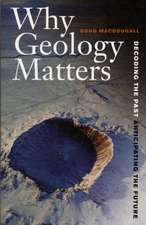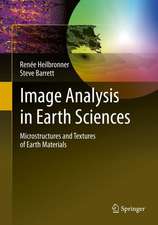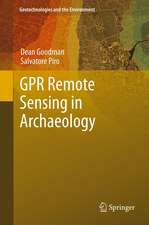The History and Sedimentology of Ancient Reef Systems: Topics in Geobiology, cartea 17
Editat de George D. Stanley Jr.en Limba Engleză Hardback – 30 noi 2001
This book opens and sets the stage with an introduction to both modern and ancient reefs and reef ecosystems. This chapter is also intended as a basic introduction for students, general geologists, and professionals or others who may be unfamiliar with reefs and reef ecosystems. The chapter addresses the living coral reef ecosystem, stressing among other relevant factors, the importance of ecological and physical interactions between the organisms and their environment. The chapter also addresses mass extinction and provides a general overview of the history of reefs.
| Toate formatele și edițiile | Preț | Express |
|---|---|---|
| Paperback (1) | 948.12 lei 43-57 zile | |
| Springer Us – 25 sep 2012 | 948.12 lei 43-57 zile | |
| Hardback (1) | 966.27 lei 43-57 zile | |
| Springer Us – 30 noi 2001 | 966.27 lei 43-57 zile |
Din seria Topics in Geobiology
- 18%
 Preț: 1858.10 lei
Preț: 1858.10 lei - 20%
 Preț: 822.09 lei
Preț: 822.09 lei - 15%
 Preț: 672.43 lei
Preț: 672.43 lei - 18%
 Preț: 1236.82 lei
Preț: 1236.82 lei - 15%
 Preț: 647.59 lei
Preț: 647.59 lei - 24%
 Preț: 885.06 lei
Preț: 885.06 lei - 18%
 Preț: 951.59 lei
Preț: 951.59 lei - 18%
 Preț: 964.23 lei
Preț: 964.23 lei - 18%
 Preț: 1117.69 lei
Preț: 1117.69 lei - 15%
 Preț: 633.31 lei
Preț: 633.31 lei - 18%
 Preț: 952.54 lei
Preț: 952.54 lei - 18%
 Preț: 949.85 lei
Preț: 949.85 lei - 18%
 Preț: 1013.50 lei
Preț: 1013.50 lei - 24%
 Preț: 821.19 lei
Preț: 821.19 lei - 18%
 Preț: 952.40 lei
Preț: 952.40 lei - 18%
 Preț: 961.23 lei
Preț: 961.23 lei - 18%
 Preț: 952.26 lei
Preț: 952.26 lei - 18%
 Preț: 960.42 lei
Preț: 960.42 lei - 18%
 Preț: 1843.11 lei
Preț: 1843.11 lei - 18%
 Preț: 954.31 lei
Preț: 954.31 lei - 18%
 Preț: 1256.41 lei
Preț: 1256.41 lei - 18%
 Preț: 959.50 lei
Preț: 959.50 lei - 15%
 Preț: 673.60 lei
Preț: 673.60 lei - 18%
 Preț: 954.14 lei
Preț: 954.14 lei - 15%
 Preț: 640.06 lei
Preț: 640.06 lei - 18%
 Preț: 959.36 lei
Preț: 959.36 lei
Preț: 966.27 lei
Preț vechi: 1178.38 lei
-18% Nou
Puncte Express: 1449
Preț estimativ în valută:
184.92€ • 192.35$ • 152.66£
184.92€ • 192.35$ • 152.66£
Carte tipărită la comandă
Livrare economică 14-28 aprilie
Preluare comenzi: 021 569.72.76
Specificații
ISBN-13: 9780306464676
ISBN-10: 0306464675
Pagini: 458
Ilustrații: XVIII, 458 p.
Dimensiuni: 155 x 235 x 33 mm
Greutate: 1.04 kg
Ediția:2001
Editura: Springer Us
Colecția Springer
Seria Topics in Geobiology
Locul publicării:New York, NY, United States
ISBN-10: 0306464675
Pagini: 458
Ilustrații: XVIII, 458 p.
Dimensiuni: 155 x 235 x 33 mm
Greutate: 1.04 kg
Ediția:2001
Editura: Springer Us
Colecția Springer
Seria Topics in Geobiology
Locul publicării:New York, NY, United States
Public țintă
ResearchCuprins
1 • Introduction to Reef Ecosystems and Their Evolution.- 1. Introduction to Reefs.- 2. What Is a Reef?.- 3. Ancient Reef Ecosystems.- References.- 2 • Phanerozoic Reef Trends Based on the Paleoreef Database.- 1. Introduction.- 2. An Outline of Phanerozoic Reef Evolution.- 3. Reef Distribution Patterns.- 4. Reef Attributes through Time.- 5. Reef Evolutionary Units.- 6. Controls on Reef Evolution.- 7. Conclusions.- References.- 3 • Evolution, Radiations, and Extinctions in Proterozoic to Mid-Paleozoic Reefs.- 1. Introduction.- 2. Precambrian Prelude: Archean-Mesoproterozoic.- 3. Neoproterozoic Reefs: First Calcimicrobes (1000-544 Ma).- 4. Cambrian Reefs: Start of Metazoan Reef Components.- 5. Ordovician Radiation and Terminal Ordovician Decline.- 6. Reefs in the Silurian-Devonian: Maximal Greenhouse.- 7. Collapse of the Mid-Paleozoic Reef Ecosystem: The Frasnian-Famennian Mass Extinctions.- 8. Summary.- References.- 4 • Paleoecology of Cambrian Reef Ecosystems.- 1. Introduction.- 2. Builders, Destroyers, and Dwellers.- 3. Spatial Distribution and Temporal Evolution of Cambrian Reefs and Reef Communities.- 4. Metazoans versus Nonmetazoans.- 5. Biotic Factors versus Abiotic Factors.- 6. Ecological Succession in Cambrian Reef Ecosystems.- 7. Mass Extinction in Cambrian Reefs.- References.- 5 • Biologically Induced Carbonate Precipitation in Reefs through Time.- 1. Introduction.- 2. Biological Induction of Marine Carbonate Precipitation.- 3. Reef Framework Construction.- 4. Nonenzymatic Reef Frameworks through Time.- 5. Reef History as a Tool for Reconstructing Earth History.- 6. Paleoecological Controls on Nonenzymatic Framework Distribution.- 7. Nonenzymatic Reef Carbonates and Global Change: Summary.- 8. Conclusions.- References.- 6 • A Half Century Later: ThePermian Guadalupian Reef Complex of West Texas and Eastern New Mexico.- 1. Introduction.- 2. Early Work in the Guadalupes.- 3. The Guadalupe Reef Barrier.- 4. Changing Ideas about the Capitan Complex.- 5. More Recent Work in the Guadalupes.- 6. Late Permian Mass Extinctions and Their Effect on the Reef.- 7. Significance of the Guadalupian Reef Complex and Future Directions of Research.- References.- 7 • Triassic Reefs of the Tethys.- 1. Introduction: What Do We Know about Triassic Reefs?.- 2. Permian, Triassic, and Lower Jurassic Reef Types.- 3. Reef Biota.- 4. Reef Paleoecology.- 5. Testimonies of Tethyan Reefs.- 6. Conclusions.- References.- 8 • Jurassic Reef Ecosystems.- 1. Introduction.- 2. Jurassic Reefs.- 3. Intrajurassic Reef Development: Faunistic Evolution or Environmental Change?.- 4. Conclusions.- References.- 9 • Cretaceous Evolution of Reef Ecosystems: A Regional Synthesis of the Caribbean Tropics.- 1. Introduction.- 2. Caribbean Geologic History.- 3. History of Caribbean Reef Ecosystems.- 4. Conclusions.- References.- 10 • The Role of Framework in Modern Reefs and Its Application to Ancient Systems.- 1. Introduction.- 2. Examples from Some Modern Caribbean Reefs.- 3. Where’s the Reef?.- 4. Summary.- References.- 11 • Coral Reefs, Carbonate Sediments, Nutrients and Global Change.- 1. Introduction.- 2. Coral Reefs and Carbonate Sediments: The Basics.- 3. The Nutrient Paradox.- 4. Advantages of Algal Symbiosis.- 5. CaCO3 Production and Nutrient Gradients.- 6. Coral Reefs and Global Change.- 7. The Future of Coral Reefs.- References.
Recenzii
'[...]this book is a tremendous source of basic information. and a relatively complete overview of modern and ancient reef systems. As such, it is a worthy addition to any carbonate geologist's library. Although not inexpensive at US $95.00, it is probably the best text presently available for upper level undergraduate and graduate level courses in reef geology. In summary, the editor and the authors should be commended for a job well done.'
Carbonates and Evaporites (2002)
Carbonates and Evaporites (2002)

















